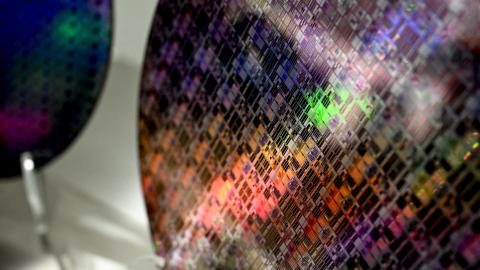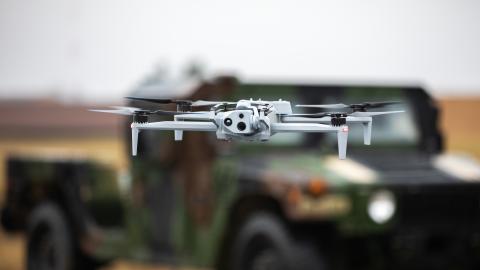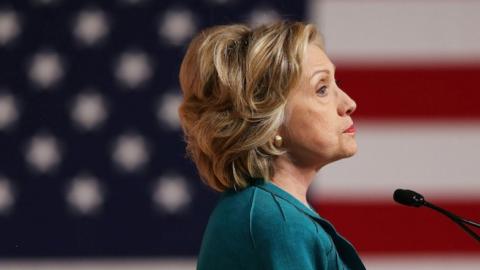The contrast between the apparent inevitability that surrounded Hillary Clinton’s procession toward the Democratic presidential nomination for so long and the air of scandal and suspicion that seems to trail behind her wherever she goes is striking. And it points to something important: Hillary Clinton isn't a candidate borne aloft on a wave of popular enthusiasm. She is no JFK, no Ronald Reagan. She is no George Wallace or William Jennings Bryan. The marching bands processing before her have to be paid; she can’t fill vast halls with cheering throngs like Bernie Sanders or, heaven help us, Donald Trump. But she soldiers gamely on, determined to struggle through the exhausting and degrading routine of the eternal campaign.
One has to ask what propels her toward the nomination with such force. Yes, it is partly her inner drive. Love her or loathe her, Hillary Clinton brings a focus to her political and professional engagements that is admirable and pure. If shaking another hand, kissing another baby, chomping down another pork chop at yet another state fair will bring her closer to the nomination, Secretary Clinton will be there, wearing her game face and giving the job all she has. And, to be fair, if it means reading another policy brief, mastering the intricacies of another important budget question, wrapping her head around another complex set of foreign policy problems, she will be there too.
But determination and grit aren’t the only forces behind her. To understand the Clinton candidacy and the odd mix of acceptance and resistance it conjures up in the party, one has to understand that she represents something that is at once very old and very new in American politics. She is a machine politician, but the machine behind her is a new kind of American political machine: a postmodern one.
The old kind of political machine, like the one Rahm Emmanuel rides in Chicago, is based on geography and office. Loyalists get contracts, favors and jobs. In return, they give money to the organization and they turn out to vote.
Chicago isn’t the last of the old time machines; American cities have been run more or less in this way for 200 years, give or take. Some, like Detroit’s dysfunctional kleptocracy, jumped the shark long ago; others, as in Los Angeles, thrive on the energy from new immigrants.
But the Clintons have invented something new. The Clinton Machine doesn’t depend on holding local offices or controlling a particular city or state; it floats untethered from geography. Bill Clinton isn’t the Mayor of anything, and he's constitutionally ineligible for another term in the White House, but few people in the United States have more influence than he does.
That isn't typical for post-Presidents. Some, notably Jimmy Carter and Herbert Hoover, continue to advocate for the issues and viewpoints they brought to their office. Many, like Gerald Ford, make speeches, play golf, and do charity fundraisers. But not since Theodore Roosevelt, who remained a major political force and was widely believed to have cinched the Republican presidential nomination for 1920 before he died, has an ex-President had the power and visibility Bill Clinton does.
Bill Clinton is charming and smart and most Americans prefer him to his successors, but that's not why he's a force in the land. He's a force in the land because he continues to operate a political machine that underwrites his wife's ambitions and his own continuing power. He is a new kind of ex-President; he and his wife share a new understanding of how power works in a new age.
The Clinton political machine, like all machines, ultimately runs on money. Somebody has to pay the apparatchiks and loyal technicians who keep the wheels turning. In traditional machines, the money came out of the rough and tumble of local politics: You stroke City Hall, and City Hall strokes you. Private contractors who depend on city contracts, public sector unions, law firms, and Wall Street banks who manage city pension funds and peddle the city’s bonds: There is an army of special interests whose businesses do well when the Mayor is a friend. But the Clintons don’t do it that way anymore; they figured out something better.
The Clintons stand where money, influence, and celebrity form a nexus. When Hillary Clinton was running the State Department and Bill Clinton was shaking down contributors to the Foundation, the donors knew, or thought they knew, what they were getting. Now that Hillary is running for President, the donors have an even better idea of what good things might come to them—or what problems and complications could develop if they cut the Clintons off.
I don’t say that the Clintons are breaking the law, at least as far as the basic principles of the machine go. As Tammany Hall’s George Washington Plunkett once said, there is such a thing as "honest graft." In the old fashioned political machine, that meant that you only take money from the group you had already decided on legitimate grounds would get the contract. The new machine offers even more opportunities for honest graft than the old kind.
The machine gathers the cash that provides perches and incomes to Clinton loyalists; the loyalists keep the publicity machine pumping, keep the networks of contacts and patronage refreshed throughout the vast Clinton network, and staff what amounts to a permanent campaign. This is what party machines used to do: provide incomes for the army of operatives who would jump into action to make sure the machine stayed in office.
But the cash doesn’t come from a system of payoffs that go all the way from the cop on the beat up to the Board of Aldermen and the Mayor. The cash comes from donations and speaking fees. When the husband of the Secretary of State or potential next President calls about a special charity project, most people, even if they happen to be CEOs of major companies or senior government officials, take the call. More than that, there will be times when government and corporate officials will reach out and make the call themselves, rather than waiting passively to hear that the Clinton machine has an ask.
The donor proposition is rock solid. Any fashionable cause that can gain applause at Davos and in the world of gentry liberalism here at home (empowering women in development, climate change, entrepreneurship and the poor, disaster relief, medical research, and and so on) gets office space and a PR package at the Foundation. Sometimes some real good gets done, though one doesn’t read much about how the Clinton Foundation’s rigorous financial controls, inspired programmatic vision, tight management, and relentless concentration on keeping costs low make it one of the leaders in philanthropy for getting the job done cheaply and effectively. What donors buy, or think they are buying, is influence and face time with two of the most powerful people in the world and their political machine; what they get on the side includes good PR, some invites and connections, one’s picture with a Clinton or a courageous and charismatic human rights figure from the developing world, and a tax deduction for a charitable contribution. For big donations, you get more; Clintons, if we can believe Donald Trump, will come to your wedding if the invite comes with enough "warmth."
Whether the Clintons understood this from the beginning, or whether they just pursued opportunities without understanding how it would all add up, they’ve discovered a new way to yoke money and power onto a self-sustaining machine. There seem to be four pillars for this new kind of edifice.
First, there are the unintended consequences of the dysfunctional campaign finance reforms" over the past thirty years that gutted traditional party organizations while empowering billionaires. Both the Democratic and Republican parties are, institutionally speaking, mere shadows of their former selves. Today, every politician is a freelance operator, accumulating bundlers and backers. Those contacts are power, and power is at least partly heritable. Being part of a political dynasty matters more when parties matter less. Look at Jeb Bush, who, "according to the AP, has received about half of his financial backing from people who supported his father and brother.
Expect to see more family firms like the Bushes and the Clintons going into politics. Daddy's rolodex is a useful thing to have.
Second, there is the synergy created by the intersection of the Power Couple and the Twenty-second Amendment, which limited Presidents to two terms. Term-limited Presidents have a hard time convincing donors that further gifts will result in future benefits. This is a problem the Clintons do not have.
Hillary Clinton is the first person who can convince power brokers that she's ready to make the transition from FLOTUS to POTUS. In former times, women were not considered serious political leaders in the United States; some wives followed their husbands into politics, but the husband, unless dead, remained at the head of the firm. Nobody thought that Lurleen Wallace was the most important politician in the Alabama Governor’s mansion. But in the 21st century, women can be wives and formidable officeholders as well. Nobody doubts that Hillary will be wearing the pantsuit if the Clintons go back to the White House.
In an age when access to money hinges on celebrity and familiarity, having two star politicians in the same family can make a big difference. The Twenty-second Amendment, adopted after Franklin D. Roosevelt smashed the third term taboo dating back to the time of George Washington, limits Presidents to two terms. But when you have a Power Couple like the Clintons, that gives you four terms in which you can dominate national life. What the Clintons have figured out is that a successful Power Couple can stay at the top of national life for decades—two terms for the first member, an interregnum of unspecified length followed, hopefully, but two terms for the second member, by which time the torch may have passed to a new generation. The Twenty-second Amendment was written to prevent the centralization of political power that would come if a powerful and popular President used his (or her) time in office to use patronage and power to build a machine that would keep the President in office indefinitely. The Clintons have found a workaround, and as a result they have changed the way political power works in the United States.
Third, the Foundation vehicle allows the Clintons to attract enormous sums of money from foreign as well as domestic donors. Unlike ordinary politicians, the Clintons can take money from foreign individuals, states and firms without breaking US laws. They can even sidestep much if not all of the odium that comes from running an American campaign with foreign money. Raising money to fight breast cancer in Botswana is a much more creditable activity than taking political contributions from an African mining company with a dubious reputation. Moreover, one can actually fight breast cancer in Botswana, or at least make moves in that direction, in ways that strengthen the network at home. The network of feminist political activists and operatives includes many people one can credibly hire to administer such a project. This is honest graft at work: one hires someone who is a reasonably qualified administrator for the program, but who is also plugged into the network of activists and operatives needed to keep the permanent campaign up and running. One can also spread the money around: the Clinton Foundation can make grants to other like minded non-profits, providing good jobs to loyal supporters.
Patronage in the service of doing good, that can effectively and legally use foreign donations in ways that build a powerful domestic political force: this might not be up there with the discovery of fire or the wheel as an invention that changes history, but it is not an insignificant contribution to the art of American governance.
At a time when globalization and the explosion of non-American wealth has changed the dynamics of wealth and power everywhere, the Clintons have built a machine that facilitates the integration of global power into American politics.
Fourth, the Clintons have captured the power of networks. Like Facebook, the Clinton network is powerful because almost everyone is part of it. Since 1992, when the Clintons stormed out of Arkansas to take the White House, they have been at the center of world power and fame. Everybody who is anybody knows them or knows of them. They can introduce anybody to anybody; they can put together the most star-studded guest list for any purpose. The power of celebrity gives them the ability to publicize and glamorize almost anything; there are powerful reasons to be part of the network that includes virtually everyone in the media, in government, in finance, in business or academia that anyone wants to know or do business with.
Opposition is the price of power, and from the “Bimbo eruptions” through Whitewater on up to Servergate, the Clintons have weathered their share of storms. As public awareness of their new political business model sinks in, expect the criticism to rise. This is partly because there is something genuinely innovative and therefore debatable in the way the Clintons acquire and hold power, and partly because Americans have a long history of disliking the institutions and intermediaries who make our system work. There was nothing the Founding Fathers hated more than political parties, but the kind of republic they wanted to build simply could not function without them. All right thinking Americans united in the 19th century to deplore the malign influence of corrupt big city political machines, but it is hard to think how else the tens of millions of immigrants streaming into those cities from all over the world could have learned to govern themselves and begin the process of integration into American life. Everybody hates lobbies and lobbyists, but it is hard to think of any other system that would allow the worlds of government and business to interact in ways that are in fact necessary for the smooth working of the economy on which all of us depend.
The postmodern political machine that the Clintons have built will stoke outrage for much the same reasons. Many find something deeply repellent in the ways that the new machine facilitates the integration of global and American politics and lobbying. Many will denounce the self-interested mingling of charity and political power-broking; others will gasp at the depth and degree of conflict of interest that a system like this inevitably entails. All these problems are real, and the Clintons, whatever their virtues, have never been at their best when it comes to disentangling the public good and their political interests. But the integrated global economy of the 21st century does need new forms of political organization that were lacking in earlier times. In an era when traditional political party institutions have been so dramatically undermined, the United States still needs organizations who keep its political life on something like an even keel. (The alternative to Clintonian machine politics might just be successive rounds of disorganized Trumpian populism. Would that really be an improvement?)
The most searching questions about the Clinton machine may not have to do with its structure or its propensity for institutionalizing and channeling power, but about the purposes to which all this power is put. In part because of its deep roots in 20th-century liberal Democratic politics, the Clinton machine is deeply entangled with interest groups and lobbies who want to perpetuate blue model governance even as the economic realities that empower the machine are no longer consistent with blue model methods. Bill Clinton's presidency advertised itself as a quest for a new kind of politics ("The era of big government is over"); Secretary Clinton seems more attuned to the ideas that, more than twenty years ago, her husband said it was time to leave behind.
It is much too early to know if Secretary Clinton will get the nomination, much less win the general election. If anything, her position looks weaker today than it did six months ago. Even the power of a great political machine cannot (yet?) deliver electoral victory on a national scale. Barack Obama (who seems increasingly interested in setting up a rival postmodern machine when his own presidency comes to an end) can tell us about that. In the old days, machine politicians had a hard time winning national campaigns; people out in the less corrupted (or, if you prefer, less sophisticated) flyover states aren’t always happy about big city politicians with big city connections.
The future of the machine is also open to question. If Secretary Clinton fails to win the election and a third try doesn’t seem either likely or feasible, the machine loses one of its most valuable assets: the connection to future political power. Will the donations continue to flow in that case, or will the machine gradually lose coherence and strength? Can Chelsea Clinton carry the machine into a new era, and does she want to? Will the partnership, often under stress, between Hillary and Bill be strong enough to fuel the machine if the return to the White House fails to occur?
The Clintons have built something new and important, if not necessarily durable or good. They have changed, at least for a time, the way power works in the United States and even in the world. They have built a new kind of institution for a different time. Politicians and power brokers all over the world are paying attention; expect many more efforts to create postmodern political machines in a time when the key institutions of governance and organization are increasingly out of date and out of tune.














